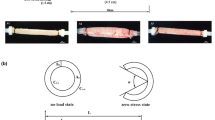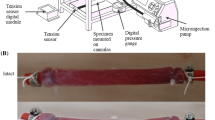Abstract
Experimental and diagnostic procedures like distension of a balloon catheter, bougie, and esophagogastroduodenoscopy can induce shear deformation in the esophageal wall. However, the shear modulus of the esophagus is yet unknown. The aim of this study was to determine the esophageal shear modulus and its dependence on the circumferential and longitudinal stresses and strains in the rat. The constitutive equation including the shear deformation based on a pseudo-strain-energy function was generated. Results were obtained using a new triaxial instrument to perform simultaneous torsion, inflation, and longitudinal stretching tests. The shear modulus varied with the inflation pressure and the longitudinal stretch ratio. The shear modulus at the longitudinal stretch ratio of 1.5 and between inflation pressures of 0 and 2.0 kPa ranged from 5.43 to 185.01 kPa. The mechanical constant of the esophagus showed that the esophageal wall was anisotropic with different stiffness in the circumferential, longitudinal, and the shear directions. The stiffness in the longitudinal direction was higher than in the circumferential direction (P < 0.001). This test can be extended for further mechanical remodeling experiments and for other tubular organs such as the small intestine or blood vessels.
Similar content being viewed by others
REFERENCES
Assentoft, J. E., H. Gregersen, and W. D. O'Brien. Determination of biomechanical properties in guinea pig esophagus by means of high frequency ultrasound and impedance planimetry. Dig. Dis. Sci. 45:1260–1266, 2000.
Cappell, M. S., and C. Huh. A study of the safety and clinical efficacy of esophagogastroduodenoscopy after esophageal, gastric, or duodenal surgery in 60 patients. Am. J. Gastroenterol.90:1268–1272, 1995.
Carew, E. O., E.A. Talman, D. I. Boughner, and I.Vesely. Quasilinear viscoelastic theory applied to internal shearing of porcine aortic valve leaflets. J. Biomech. Eng. 121:386–392, 1999.
Champion, J. K., N. Delise, and T. Hunt. Myenteric plexus in spastic motility disorders. J. Gastrointest. Surg. 89:2187–2190, 2001.
Delfino, A., N. Stergiopulos, J. E. Moore, and J. J. Meister. Residual strain effects on the stress field in a thick wall finite element model of the human carotid bifurcation. J. Biomech. 30:777–786, 1997.
Deng, S. X., J. Tomioka, J. C. Debes, and Y. C. Fung. New experiments on shear modulus of elasticity of arteries. Am. J. Physiol. 266:H1–H10, 1994.
Fung, Y. C. Biomechanics. Properties of Living Tissues.Berlin: Springer, 1993.
Fung, Y. C., K. Fronek, and P. Patitucci. Pseudoelasticity of arteries and the choice of its mathematical expression. J. Physiol. 237:620–631, 1979.
Gregersen, H. Residual strain in the gastrointestinal tract: A new concept. Neurogastroenterol. Motil. 12:411–414, 2000.
Gregersen, H. Biomechanics of the Gastrointestinal Tract. London: Springer, 2002.
Gregersen, H., and X. Lu. Regional distribution of axial strain and circumferential residual strain in the layerd rabbit oesophagus. J. Biomech. 34:225–233, 2001.
Holzapfel, G. A., T. C. Gasser, and R.W. Ogden. A new constitutive framework for arterial wall mechanics and a comparative study of material models. J. Elasticity 61:1–48, 2000.
Humphrey, J. D. Mechanics of arterial wall: Review and directions. Crit. Rev. Biomed. Eng.23:1–162, 1995.
Liao, D. H., Y. H. Fan, Y. J. Zeng, and H. Gregersen. The stress distribution in the layered wall of esophagus. Med. Eng. Phys. 25:731–738, 2003.
Liu, S. Q., and Y. C. Fung. Material coefficients of the strain energy function of pulmonary arteries in normal and cigarette smoke-exposed rats. J. Biomech. 26:1261–1269, 1993.
McLean, G. K., and R. F. LeVeen. Shear stress in the performance of esophageal dilation: Comparison of balloon dilation and bougienage. Radiology 72:983–986, 1989.
Nicosia, M. A., and J. G. Brasseur. A mathematic model for estimating muscle tension in vivo during esophageal bolus transport. J. Theor. Biol. 219:235–255, 2002.
Petersen, J. A., B. U. Duch, and H. Gregersen. Luminal crosssectional area and wall distensibility in the isolated porcine oesophagus. Int. J. Surg. Invest. 1:23–28, 1999.
Phillips, R. J., and T. L. Powley. Tension and stretch receptors in gastrointestinal smooth muscle: Re-evalusting vagal mechanoreceptor eletrophysiology. Brain Res. Rev. 34:1–26, 2000.
Ren, J., B. T. Massey, W. J. Dodds, M. K. Kern, J. J. Brasseur, R. Shaker, S. S. Harrington, W. J. Hogan, and R. C. Arndorfer. Determinants of intrabolus pressure during esophageal peristaltic bolus transport. Am. J. Physiol. 264:G407–G413, 1993.
Villadsen, G. E., J. H. Storkholm, L. Hendel, H. Vilstrup, and H. Gregersen. Impedance planimetric characterization of esophagus in systemic sclerosis patients with severe involvement of esophague. Dig. Dis. Sci. 42:2317–2326, 1997.
Zhou, J., and Y. C. Fung. The degree of nonlinearity and anisotropy of blood vessel elasticity. Proc. Natl. Acad. Sci. U.S.A. 23:14255–14260, 1997.
Author information
Authors and Affiliations
Rights and permissions
About this article
Cite this article
Yang, J., Liao, D., Zhao, J. et al. Shear Modulus of Elasticity of the Esophagus. Annals of Biomedical Engineering 32, 1223–1230 (2004). https://doi.org/10.1114/B:ABME.0000039356.24821.6c
Issue Date:
DOI: https://doi.org/10.1114/B:ABME.0000039356.24821.6c




